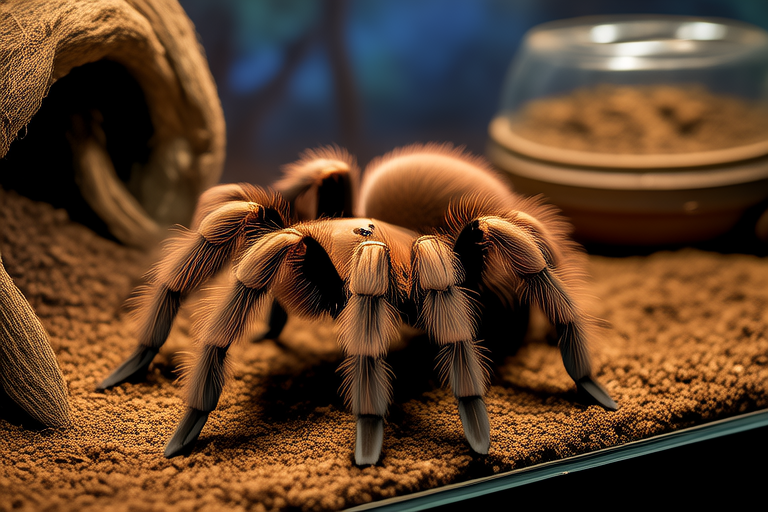Setting Up the Perfect Habitat for Your Chilean Rose Tarantula
Welcome to your comprehensive guide on creating the ideal habitat for your Chilean Rose Tarantula. Whether you’re a seasoned tarantula owner or a beginner, this guide will walk you through every step of setting up a safe, comfortable, and stimulating environment for your pet. From enclosure size to lighting requirements, we’ll cover everything you need to know to ensure your tarantula thrives.
Enclosure Size
The first step in setting up the perfect habitat is choosing the right enclosure size. For a Chilean Rose Tarantula, a tank that measures approximately 10 gallons (38 liters) is adequate for an adult. This provides enough space for movement and climbing, which are crucial activities for their physical health and mental stimulation. However, if you plan to house multiple tarantulas or larger species, consider a bigger tank.
Substrate Type and Depth
Selecting the right substrate is vital for your tarantula’s comfort and well-being. Coconut fiber, cypress mulch, or orchid bark are excellent choices due to their moisture retention and ease of maintenance. The substrate should be at least 4 inches deep to allow for burrowing and natural behavior. Avoid substrates like sand, as they can cause impaction if ingested.
Temperature and Humidity Levels
Maintaining appropriate temperature and humidity levels is essential for your tarantula’s health. The ideal temperature range for a Chilean Rose Tarantula is between 75°F and 85°F (24°C to 29°C). Use a digital thermometer to monitor the temperature inside the enclosure. A hygrometer will help you keep track of humidity, which should be around 60% to 80%. You can adjust these levels by adding water dishes or misting the substrate.
Ventilation Needs
Proper ventilation ensures fresh air circulation within the enclosure, preventing the buildup of harmful bacteria and fungi. Ensure there are sufficient holes or mesh on the tank lid for airflow while still keeping the tarantula secure. Avoid drafts and direct sunlight, as they can cause temperature fluctuations detrimental to your pet.
Hiding Spots
Your tarantula needs a safe place to retreat when feeling threatened or during molting. Provide multiple hiding spots made from cork bark, half logs, or commercially available shelters. Place these items on top of the substrate to mimic natural environments. Ensure they are stable and won’t collapse under the weight of your tarantula.
Decor Elements
Incorporate various decor elements to create an engaging and enriching environment. Add branches, vines, and artificial plants to stimulate exploration and climbing. These items also provide additional hiding spots and help maintain humidity levels. Be cautious with live plants, as they may introduce pests or require excessive care.
Lighting Requirements
Chilean Rose Tarantulas do not require UVB lighting; however, providing a low-wattage red bulb or a ceramic heat emitter can assist in maintaining the correct temperature gradient. Never use spotlights or bulbs that emit intense heat, as they can burn your tarantula. Always consult a reptile veterinarian before introducing new lighting systems.
Feeding Stations
Designate specific areas within the enclosure for feeding. This helps prevent substrate contamination and makes it easier to remove uneaten prey. You can use small dishes or platforms designed for tarantulas. Ensure the food items are appropriate for your tarantula’s size and age. Feed them once or twice a week, depending on their appetite and activity level.
Cleaning Schedules
A regular cleaning schedule is crucial for maintaining a healthy environment. Spot clean daily by removing any uneaten prey, feces, or shed skin. Perform a full cleaning every two weeks, replacing the substrate and disinfecting all surfaces. Use pet-safe cleaning products and thoroughly rinse and dry the enclosure before reintroducing your tarantula.
Safety Precautions
Handling your tarantula requires extreme caution. Always wash your hands before and after interaction to avoid transferring oils or chemicals. Gently scoop your tarantula into a secure container for transport. Never handle them by the legs or abdomen, as this can cause injury. If your tarantula feels threatened, it may flick urticating hairs, which can irritate human skin. Wear protective clothing and eyewear if handling is necessary.
Tips for Maintaining a Healthy Environment
- Monitor Temperature and Humidity: Regularly check the temperature and humidity levels to ensure they remain within the recommended range. Adjust heating and humidifying devices as needed.
- Provide Fresh Water: Offer a shallow dish of clean water daily. Replace it immediately if it becomes dirty or moldy.
- Encourage Natural Behavior: Stimulate your tarantula’s natural instincts by providing climbing structures and hiding spots. Rotate decor items periodically to keep the environment interesting.
- Handle with Care: Limit handling to minimize stress and potential injuries. When handling is necessary, always use gentle techniques and protective gear.
Addressing Common Setup Challenges
Even with careful planning, challenges may arise when setting up your tarantula’s habitat. Here are some common issues and solutions:
- Substrate Clumping: If your substrate clumps together, causing discomfort for your tarantula, try mixing in a small amount of vermiculite or perlite to improve its texture.
- Excessive Humidity: High humidity levels can lead to mold growth and respiratory issues. To reduce humidity, increase ventilation and use a dehumidifier if necessary.
- Uneaten Prey: Remove uneaten prey promptly to prevent contamination and potential health risks. If your tarantula consistently leaves food, adjust the frequency and size of feedings.
By following this guide, you’ll be well on your way to creating a thriving habitat for your Chilean Rose Tarantula. Remember, a happy and healthy tarantula is a result of consistent care, attention to detail, and a commitment to their well-being. Enjoy the rewarding experience of caring for one of nature’s most fascinating creatures.
